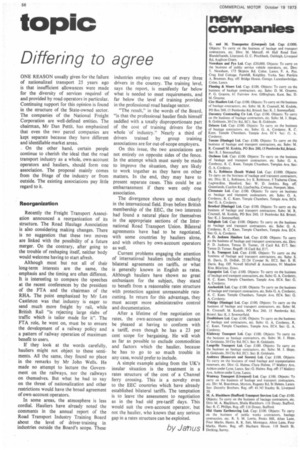topic
Page 58

If you've noticed an error in this article please click here to report it so we can fix it.
Differing to agree
ONE REASON usually given for the failure of nationalized transport 25 years ago is that insufficient allowances were made for the diversity of services required of and provided by road operators in particular. Continuing support for this opinion is found in the structure of the State-owned sector. The companies of the National Freight Corporation are well-defined entities. The chairman, Mr Dan Pettit, has emphasized that even the two parcel companies are kept separate because they have different and identifiable market areas.
On the other hand, certain people continue to cherish the• ideal that the road transport industry as a whole, own-account operators and hauliers, should form one association. The proposal mainly comes from the fringe of the industry or from outside. The existing associations pay little regard to it.
Reorganization Recently the Freight Transport Association announced a reorganization of its structure. The Road Haulage Association is also considering making changes. There is no suggestion that these two moves are linked with the possibility of a future merger. On the contrary, after going to the trouble of reshaping itself, neither body would welcome having to start afresh.
Although most but not all of their long-term interests are the same, the emphasis and the timing are often different. It is interesting to compare the speeches at the recent conferences by the president of the FTA and the chairman of the RHA. The point emphasized by Mr Len Castleton was that industry is eager to send much more freight by rail, while British Rail "is rejecting large slabs of traffic which is tailor made for it". The FTA role, he went on, must be to ensure the development of a railway policy and a pattern of railway operation of maximum benefit to users.
If they look at the words carefully, hauliers might not object to these sentiments. All the same, they found no place in the remarks by Mr John Wells. He made no attempt to lecture the Government on the railways, nor the railways on themselves. But what he had to say on the threat of nationalization and other restrictions would have the broad agreement of own-account operators.
In some areas, the atmosphere is less cordial. Hauliers have already noted the comments in the annual report of the Road Transport Industry Training Board about the level of driver-training in industries outside the Board's scope. These industries employ two out of every three drivers in the country. The training level, says the report, is manifestly far below what is needed to meet requirements, and far below the level of training provided in the professional road haulage sector.
"The result," in the words of the Board, "is that the professional haulier finds himself saddled with a totally disproportionate part of the cost of training drivers for the whole of industry." Nearly a third of drivers trained by group training associations are for out-of-scope employers.
On this issue, the two associations are not entirely on opposite sides of the fence. In the attempt which must surely be made to improve the situation, they are likely to work together as they have on other matters. In the end, they may have to present separate cases. This could be an embarrassment if there were only one association.
The divergence shows up most clearly in the international field. Even before British membership of the EEC, the two interests had found a natural place for themselves in the appropriate sections of the International Road Transport Union. Birateral agreements have had to be negotiated, with some countries by hauliers alone, and with others by own-account operators as well.
Current problems engaging the attention of international hauliers include reaching bilateral agreements on tariffs, or what is generally known in English as rates. Although hauliers have shown no great enthusiasm for the subject, they stand to benefit from a reasonable rates structure with protection against unreasonable ratecutting. In return for this advantage, they must accept more administrative control and documentation.
After a lifetime of free negotiation on rates, the own-account operator cannot be pleased at having to conform with a tariff, even though he has a 23 per cent scope for bargaining. He will wish as far as possible to exclude commodities and factors which the haulier, because he has to go to so much trouble in any case, would prefer to include.
A simple example arising from the UK's insular situation is the treatment in a rates structure of the cost of a Channel ferry crossing. This is a novelty even to the EEC countries which have already established bilateral tariffs. The temptation is to leave the assessment to negotiation as in the bad old pre-tariff days. This would suit the own-account operator, but not the haulier. who knows that any serious gap in a rates structure can be exploited.
by Janus








































































































